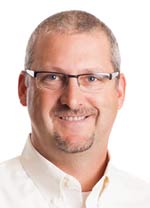2014 Winner: HMB and the $149 Squeeze Ball
- By Scott Bekker
- October 01, 2014
A debate over a squeeze ball, those promotional toys that end up in the junk drawer of every tradeshow and job fair attendee ever, gave HMB Inc. the bounce it needed.
CEO Tom Harris sets the scene as a run-of-the-mill 2008 meeting of key employees of the Columbus, Ohio-based business technology services firm with a Microsoft Silver Competency in Application Development.
"One day we were sitting in our operations meeting. The recruiting coordinator came in and wanted to spend $149 for squeeze balls. We debated that $149 purchase for about 45 minutes. Can we get them cheaper? What logo are we going to use?" Harris recalls.
Then came the realization, Harris says: "This is ridiculous, we just spent about $3,000 of company time on a $149 decision."
Knowing that something needed to change didn't occur in a vacuum. The stock market decline had begun and the recession was becoming apparent everywhere. Harris and another co-founder, John Mackessy, were also a little on edge over the retirement of Patrick Brennan, the "B" in HMB.
 "We really started down that restructuring path in 2009 and 2010. ... We didn't want to disrupt the company too much. It's like engine parts. If you put it all together, it runs pretty well."
"We really started down that restructuring path in 2009 and 2010. ... We didn't want to disrupt the company too much. It's like engine parts. If you put it all together, it runs pretty well."
Tom Harris, CEO, HMB Inc.
The retirement was completely amicable, but Harris remembers it was also a wake-up call. "At that time, everything ran through us -- recruiting, sales, account management, accounting. We did everything," he says. What if something happened to one of the two remaining founders? "The answer wasn't very good. It was kind of scary. We didn't purposely not share details. It was how we'd been running the business."
It was a case of a company culture that had been great at one size, but was preventing HMB from finding another gear.
The co-founders started the firm in 1994 out of frustration working elsewhere as developers. "A small percentage of people were compensated very well and were receiving all the rewards for the success of all the people," Harris says of the culture the trio rejected. "We thought, 'We can create a company for consultants run by consultants.' We wanted to reward high performers, but the people in the trenches doing the job, they're the ones who need incentives. When we had success at a customer site, we wanted to reward the people who were there. The sales guy didn't do it all."
In addition to profit sharing, another cultural factor was becoming problematic by 2008. "The other mantra that we had that was very near and dear to us from a culture perspective was that we're all out there working. We don't have a lot of overhead. For the first 16 years, all the people in the firm worked at client sites, including myself and the other founders. No job is not good enough for us. We've always believed in that."
The business grew fast in the 1990s, but the everyone-in-the-trenches attitude probably kept the business from breaking out of the high-30s/low-40s consultant range for most of the 2000s, Harris now believes.
The $149 squeeze ball sparked another conversation within the leadership team that had a much higher return on investment. "We were really good at working in the business and not on the business," Harris says. "A couple of us said, 'We're not going to be billable employees anymore. We're going to work in the headquarters, and we're going to build the business.'"
Part of building the business involved creating structure. "We didn't have job titles for a lot of people, including ourselves. We needed to grow up from a business perspective," Harris says.
The restructuring that followed started with a full-time recruiter and then a second one -- empowered to make squeeze-ball-spending and other decisions. HMB created lines of business with profit and loss responsibility and put leaders in charge of them. In order to support fast growth, HMB formalized a mentoring and training program, called HMB University.
Another important cultural shift was recognizing the value of sales efforts. "The majority of our business prior to 2008 was referrals. Just committing to sales was a big deal for us," Harris says.
Those changes paid off with 13.5 percent revenue growth in 2011, 22 percent growth in 2012, 9 percent growth in 2013 and close to 18 percent growth projected for this year. A company that was stuck at around 40 employees through the 2000s is now at 165 employees, including 38 additions in 2013. The company publicly announced plans to hire 75 more employees in central Ohio over the next few years.
"We really started down that restructuring path in 2009 and 2010. We're still on that road. We're 85 percent there," Harris says. "We didn't want to disrupt the company too much. It's like engine parts. If you put it all together, it runs pretty well. It's been fun to sit back and watch; fun to see their excitement and their ideas get implemented."
Read the full 2014 RCP Rocket Award winners feature here.
<< Back to the RCP Rocket Awards Page
About the Author
Scott Bekker is editor in chief of Redmond Channel Partner magazine.